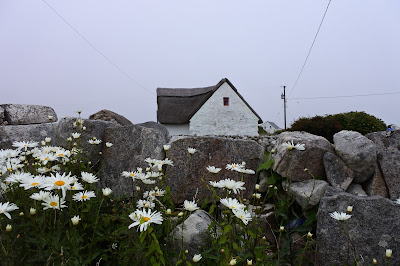I still have a ways to go with my unpacking and laundry chores, but I have finished sorting out my photos from the three weeks I spent in Ireland. I couldn't wait to look at them on a bigger screen. I didn't know where to start my story--I'm overwhelmed--so I decided to plunge in to the middle, actually near the end of my journey, and show my dear readers the Connemara region of western Ireland. Kathy and I took a bus tour from Galway last Sunday and enjoyed the scenery as well as the narration by our driver, Martin.
 |
| Low clouds over the Maamturk Mountains |
Those Maamturk Mountains are made of quartz schist and granite, and rocks of those substances pop up all over the landscape. In order to make the land farmable, farmers have been digging them up for centuries and making dry stone walls with them. Apparently farmers do this in the U.S., too, but what do I know? Kathy says the fieldstone dry stone walls in Pennsylvania look different because the fieldstones are flatter. I thought it was interesting that the stones are just piled up without benefit of sand or concrete or grout. They've lasted for centuries like that.
The walls are used to mark property borders, field borders, to keep animals in, and to give animals shelter in bad weather.
 |
| Gawkable Connemara scenery |
Speaking of fields, many of them are inhabited by Connemara Black-faced
sheep. Sheep are a big part of the economy here, and I almost hate to
tell you this, but these sheep are mainly used for meat and the wool of
the survivors is not spun into sweater yarn. It is spun into yarn for
carpets. Typically, farmers have anywhere between 100 and 500 sheep in
their herds and they brand their own with big splotches of color on
their backs. We saw red, blue, and orange.
Have you seen the John Wayne/Maureen O'Hara movie,
The Quiet Man? It was
filmed in this region of Ireland in 1951. There's a little bridge here
that we saw from the bus. It is seen in the movie and now known as The
Quiet Man Bridge by the locals. The movie in DVD form is available in
gift shops all over, but I'm confident my friends at the TCM channel
will show it soon. I'm going to make a guess that old-fashioned thatched-roof houses also make appearances in that film and in another,
The Field (1989), starring Richard Harris. These houses still exist, but they are mostly used for tourist "holiday" houses now, and the roofs are no longer straw but reeds. (Underneath is a layer of metal to help prevent fires from spreading.) These and other houses are heated with turf taken out of bogs. The turf is dried and burnt as fuel. We saw from the bus where turf has been removed in a few places, and Martin the driver told us there are laws limiting how much turf can be taken out. It takes hundreds of years to form.
 |
| Actual thatched-roof house |
We passed a fjord near the town of Leenane. A fjord is a finger of deep water forming an inlet surrounded by mountains. Glaciers were involved in their formation. Keep your eyes open for a play called "The Beauty Queen of Leenane" because its playright Martin McDermott was inspired by this location.
 |
| Fjord |
This area of water is also called Kilary Harbor, and it was here that we saw a Fairy Tree!
 |
| Fairy Tree |
The legend goes that if you leave something of value on the Fairy Tree and make a wish, fairies will make sure your wish comes true. It looked like most people left rags and socks and gloves, and we saw a child's rain boot also. (It probably had value to the child.) I didn't leave anything, but instead took a picture. By the way, that is a hawthorne tree. We saw many of them shaped like this from the Connemara wind.
Waterfalls are found all over Connemara, and our bus driver Martin knew we'd be interested in photographing them.
 |
| Small waterfall |
 |
| Larger waterfalls |
The highlight of this tour was
Kylemore Abbey and its Victorian Walled Garden. This gargantuan gawkable home was built by a wealthy doctor for his lovely wife, Margaret in 1920. It then became a monastery for nuns who ran a boarding school there. The nuns eventually gave up the school and devoted their time to tourism. There's a small Gothic church nearby where Mitchell and Margaret Henry are buried. I'll be quiet now and share some shots of the property...
 |
| I look confused. |
 |
| What ARE these? |
 |
| More yellow |























No comments:
Post a Comment